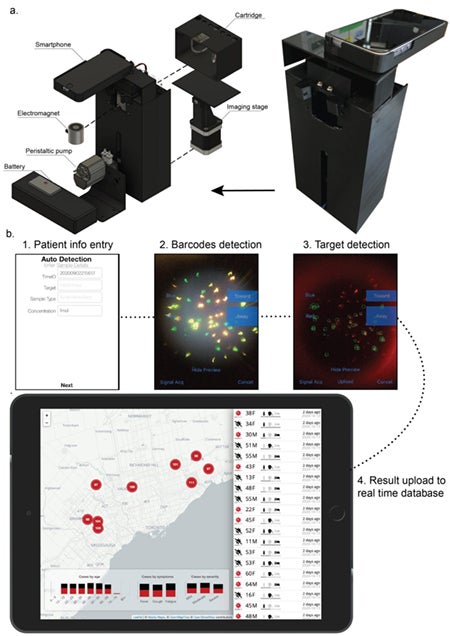Researchers develop quantum dot smartphone device to diagnose and track COVID-19

U of T PhD candidates Ayden Malekjahani and Johnny Zhang are co-authors of a study detailing the development of a portable, smartphone-based quantum barcode serological assay device for real-time surveillance of patients infected with SARS-CoV-2.
Published: June 17, 2021
Researchers at the University of Toronto, in collaboration with Sunnybrook Health Sciences Centre, Public Health Ontario and Mount Sinai Hospital, have developed a COVID-19 antibody test that makes use of a smartphone camera.
The test could significantly improve the turnaround time and efficiency of infectious disease diagnosis, both for COVID-19 and beyond. The work is published in the latest issue of Nano Letters and involves U of T researchers from the Institute of Biomedical Engineering, department of chemistry in the Faculty of Arts & Science and Donnelly Centre for Cellular and Biomolecular Research.
“The goal of the study is to make COVID-19 antibody tests more accessible.” said Johnny Zhang, a PhD candidate at the Institute of Biomedical Engineering and department of chemistry who is one of the co-first authors of the publication.
“The end result is that the patients can take a self-diagnosis for COVID-19 with their phone, and that data can be immediately accessed digitally by medical professionals.”
The typical workflow for infectious disease diagnostic testing involves obtaining a sample from the patient, sending it to a laboratory for diagnostic testing and distributing the result to clinical personnel for decision making. The processes are often siloed and have a long turn-around time.

By contrast, the U of T and hospital researchers developed a portable smartphone-based quantum barcode serological assay device for real-time surveillance of patients infected with SARS-CoV-2. They engineered quantum dot barcoded microbeads and a secondary label to search for antibodies against COVID-19 antigen in a patient’s blood. Finding the antibodies leads to a change in microbead emission colour.
The beads are then loaded into the device, activated with a laser, and the signal is imaged using a smartphone camera. An app is designed to process the image to identify the bead’s emission change. Finally, the data are interpreted and transmitted remotely across the world for data collection and decision making.
“The beauty of the system is that everything is integrated into one portable unit.” said Zhang.
This technology, by which quantum dot microbead detection can measure minuscule amounts of key biomarkers in blood, has been in development for the past 10 years.
“We really wanted to improve the performance and utility of the technology this time around,” said PhD candidate Ayden Malekjahani, the other co-first author of this study.
“Being able to detect traces of target in patients is not enough. We wanted to add more functions to the device. We designed the device to simultaneously detect multiple antibodies from different sample types, so each test run is packed with information. The results are then uploaded to an online dashboard where medical professionals and the public can see trends in real time.”
The researchers tested the device with 49 patient blood samples where varying degrees of COVID-19 infection were present, and were able to achieve 84-88 per cent sensitivity. Although this result is not as high as traditional tests, it is still approximately three times higher than lateral flow assays, which are currently the most commonly available portable antibody tests.
This result also means detecting COVID-19 antibody can now be done outside of the centralized facilities without a big drop in accuracy.
This research was a collaboration with the Public Health Ontario, Sunnybrook Hospital and Mount Sinai Hospital, where clinical samples were provided to the researchers to test and evaluate this new system.
“This device can be a game-changer in the way we monitor the spread of infectious diseases and a patient’s response to vaccines.” said Professor Warren Chan, director of the Institute of Biomedical Engineering, and the corresponding author of this research.



